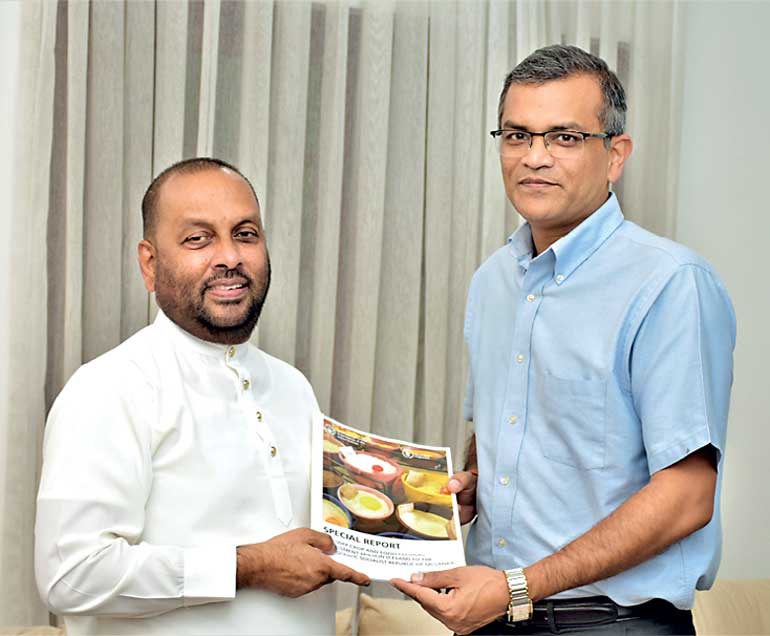Sunday Dec 15, 2024
Sunday Dec 15, 2024
Tuesday, 13 September 2022 01:40 - - {{hitsCtrl.values.hits}}


The joint FAO-WFP Crop and Food Security Assessment Mission (CFSAM) report on Sri Lanka being handed over to Agriculture Minister Mahinda Amaraweera by FAO Representative for Sri Lanka and the Maldives Vimlendra Sharan
An estimated 6.3 million people in Sri Lanka are facing moderate to severe acute food insecurity and their situation is expected to worsen if adequate life-saving assistance and livelihood support are not provided, the Food and Agriculture Organisation of the United Nations (FAO) and the United Nations World Food Program (WFP) warned yesterday in a new report.
Two consecutive seasons of poor harvests led to a nearly 50% drop in production coupled with reduced imports of food grains due to foreign exchange constraints, according to the joint FAO/WFP Crop and Food Security Assessment Mission (CFSAM) report.
The report notes that immediate food assistance and livelihood programs –including through existing social assistance mechanisms – are critical to enabling households to access nutritious food – particularly moderately and severely acute food insecure ones.
Without assistance, the food security situation is expected to deteriorate further, particularly during October to February 2023 lean season, driven by poor harvests of staple foods, in particular paddy rice, and the ongoing economic crisis.
“In order to avert a further deterioration of food security conditions and to support restoration of agricultural production, livelihood assistance targeting smallholder farmers should remain a priority,” said FAO Representative in Sri Lanka Vimlendra Sharan.
“With around 30% of the population depending on agriculture, improving the production capacity of farmers will ultimately boost the resilience of the agricultural sector, reduce import requirements amid shortages of foreign currency reserves and avert the rise in hunger.”
“Months into this crippling economic crisis, families are running out of options – they are exhausted. More than 60% of families are eating less, and eating cheaper, less nutritious food. This comes at a time when financial constraints have forced the Government to scale back on nutrition programs, such as school meals and fortified food to mothers and undernourished children.
“WFP’s top priority is to provide immediate food and nutrition assistance to the most at-risk communities to prevent a further deterioration of their nutrition,” said WFP Representative and Country Director in Sri Lanka Abdur Rahim Siddiqui.
At the request of the Government, the joint Crop and Food Security Assessment Mission visited all 25 districts in the country between June and July to analyse agricultural production levels in 2022, particularly of main staple cereals, as well as to assess household food security conditions.
Significant decline in harvests
A severe macroeconomic crisis in Sri Lanka has caused acute shortages and spikes in the prices of essential products, including food, agricultural inputs, fuel and medicine, severely compromising the economic activity, with major disruptions to agricultural production.
Production of paddy rice, the main food staple, is forecast at 3 million MT in 2022, the lowest level since the 2017 drought-affected harvest, mostly due to low yields following reduced application of fertilisers, the report finds.
Production of maize, mostly used as animal feed, is about 40% below the past five-year average, with negative effects on poultry and livestock production.
Likewise, the production of vegetables, fruits and export-oriented crops, such as tea, rubber, coconut and spices, is well below average, causing a significant decline in households’ income and export revenues.
Prices of most food items have been on a steady rise since the last quarter of 2021 and reached a new record high in August, with the year-on-year food inflation rate at nearly 94%.
The total cereal import requirement in 2022 is estimated at 2.2 million MT. In the first six months, over 930,000 MT of cereals were imported, leaving an outstanding import requirement of 1.27 million MT. Given the persisting macroeconomic challenges, there is a high risk that the remaining import requirement will not be met.
Mission recommendations
The key recommendations by the joint FAO/WFP Mission are the immediate provision of food or cash-based assistance to vulnerable and marginalised communities, including pregnant and breastfeeding women, women-headed households and persons with disabilities, to help them meet their immediate food and nutrition needs.
The report also recommends the immediate provision of agricultural inputs, including fertilisers, focusing on smallholder farmers. The report outlines the need to support households to establish home gardens and backyard gardening to enhance their nutritional status while providing adequate amounts of fuel to ensure effective planting, harvesting, transportation and processing of food crops.
The report suggests providing high-nutrient animal feed, vaccines and veterinary health kits at a subsidised price to livestock owners, especially dairy and poultry to mitigate the impacts of the feed shortages.
Support for the resumption and continuation of national nutrition programs such as school meals, which faced disruptions due to funding constraints, were also highlighted as a priority.